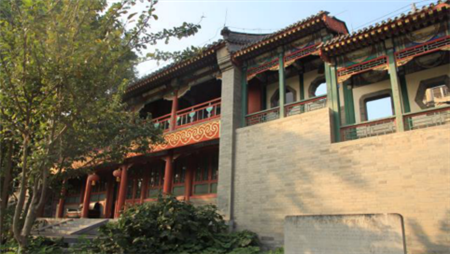: Chengze Garden, whose name means “to accept bliss from emperor” in Chinese, is located on the west bank of Wanquan River that winds through many ancient gardens, including the famous Old Summer Palace. It covers an area of 1.97 hectares, marginally larger than Weixiu Garden, which is the smallest garden at PKU. Although Chengze Garden is a resplendent royal garden with awe-inspiring scenery, it is not usually considered as a prominent landmark of PKU, since most PKUers, even the ones who have lived on campus for many years, are not well-acquainted with the westernmost region of the PKU campus. In fact, most PKUers are concentrated at regions revolving Yanyuan Garden, which serves as the workplace of some departments, as well as the location where most students study and live. That being said, Chengze Garden is still widely-known for its well-preserved main buildings and basic layouts after decades of wars and political turmoils in the first half of the 20th century.
Like other Qing dynasty royal garden complexes in the suburbs of Western Beijing, Chengze Garden is featured by poetic scenery where grand buildings gracefully illustrated elaborate and exquisite colored patterns from top to bottom. Chengze Garden in its heyday, according to the historical record, was divided into the south and north region by various lakes and brooks. Major landscapes were mainly concentrated in the north, including old pavilions, long verandahs, outstanding stoneworks and lotus pools.
Buildings and verandahs in Chengze Garden (2019)
Built in 1725, which was the 3rd year of Emperor Yongzheng’s reign (1678-1735), Chengze Garden went through several handovers. Its first owner was Prince Yunli (1697-1738), a younger brother of Yongzheng, who designated this serene place as his residence. Later in 1845, Emperor Daoguang (1782-1850) redistributed royal gardens and gave Chengze Garden to his 6th daughter, Princess Shou’engulun (1830-1859). Towards the end of Qing Dynasty, the ancient garden welcomed a new owner, Prince Ching (Yikuang, 1838-1917), who was a brother of Emperor Guangxu (1871-1908). At the time when the garden was redistributed to Prince Ching, China experienced the most profound social transformation in its 5000-year-long history. It was a time when the once-powerful Qing Dynasty was on its decline, and China was encountering retreats and defeats in resistance against imperialist powers. Ultimately, the Qing government was forced to sign treaties with invaders, which forfeited China’s sovereignty and territorial integrity. Prince Ching was among those Qing’s major representatives on the negotiating table with foreign aggressors. Several years later, he became the right-hand man of Yuan Shikai (1859-1916), who was the main driver of the Qing Dynasty’s degradation and the leader of Beiyang Government. The prince, as the principal of Qing’s foreign affairs, set his office near the Chengze Garden. The garden thus became the banquet hall for Prince Ching and foreign envoys. Chengze Garden’s reassigned purpose became a probable explanation for the garden’s survival from the historical catastrophe in 1900, when invaders of Eight-Nation Allies destroyed almost all landscape of Old Summer Palace Complexes.

An old photo of the landscape of Chengze Garden
After the Revolution in 1911, Prince Ching left for Tianjin and sold this garden to Zhang Boju (1898-1982), an upperclass socialite who was proficient in art collection, calligraphy, painting and Peking Opera. In 1952, China’s post-secondary institutions were undergoing structural reform, changing most universities and colleges by either splitting or merging. Peking University, being one of the many that was experiencing this transformation, merged with Yenching University. Zhang Boju, who was a History of Art professor at Yenching University, sold Chengze Garden to PKU. The University then rebuilt the southern part of the garden as a residential community, which included 20 buildings for the staff and post-doctoral students, and a cottage area with 65 households. While its splendor as a royal garden still can be seen in those time-honored compounds located in the northern region.
Chengze Garden was listed as key protected historic site by Beijing Municipal Government in 1992 and 1999, as a way to prevent further damage to its picturesque landscape. In 1998 during the 100th anniversary of the university’s foundation, PKU renovated principal buildings of Chengze Garden based on old pictures and records, with the Princess Duplex as a branch office of National School of Development.
References:
Dongfa Xiao, Yun Li, Hong Shen, “Chengze Garden” in the Scenery and Cultural Richness of Yanyuan. Beijing: Beijing Library, 2003, 87-92.[肖东发,李云,沈宏:承泽园,载《风物:燕园景观与人文底蕴》,北京:北京图书馆出版社,2003:87-92]
“Introduction to famous gardens in Peking University: Chengze Garden.” [北京大学新闻网:北大名园访胜:承泽园]
Written by: Bai Qingwen
Edited by: Zhang Jiang, Rose Li
Photo Credit to: PKU Office of Real Estate Management, oldbeijing.org

